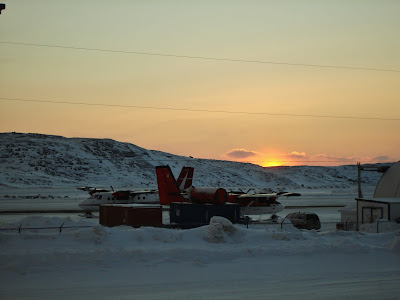We had a great opportunity to go dog sledding this week with Inukpak Outfitters. As I’m married to a pilot, and a good looking one at that, Josh had picked out a bright, sunny day and an awesome guide. The sled dogs are kept out on the sea ice all winter long. They’re fed specialized kibble or seal meat on alternating days. Approaching this team made them growl, bark and howl at a deafening volume. Their ‘welcome’ was very intimidating, but their wagging tails told their true intentions….that they were ecstatic to see us and loved the opportunity to pull the sled.
The twelve dogs that pulled us were “Canadian Sled Dogs,” descendants of the dogs that the Inuit people originally brought over while crossing over Greenland. As opposed to the sled dogs of the south, these dogs are thicker, stronger, and taller. This allowed the Inuit to be able to have teams of five or six dogs that could pull the same the same weight as a team of ten faster dogs. In the old days, food was scarce and so it was easier to feed a team with fewer dogs.
We started off our trip with an introduction to each dog and learned where he ran in the team. It was interesting to learn that each dog had its own role. Some are straight and steady pullers. Some are super energetic [read: hyper] and motivate the others to run faster. One dog was responsible to set the pace. And one is the alpha male and he keeps everyone else in line. One dog even got loose and was doing laps around us all morning, just like Casey (Tyler and Kelsey’s dog).
After our introductions, the dogs were harnessed and hooked up to the qamutik. In the north, the sled driver sits in the front to steer the sled and cue the dogs. This is different from the stereotypical southern idea where the driver stands at the back of the sled. In the Arctic, this exposure to the icy wind is dangerous. It was also interesting to see our guide was no doubt leader of the pack to the sled dogs. At times he would get off the sled as we were moving and run to the right or left to change the dogs’ direction as they all followed him.
With a “Ready” and “Iyii-yiyi”, the sled took off over ice. Once we got past the rough ice, the frozen ocean was quite smooth. The snow sparkled all around us with a million shining snow flakes. There was no wind that morning, so we enjoyed the quiet whoosh of the qamutik skis as the dogs ran silently over the ice. Josh and I can now say that we’ve dog sledded on the ocean. It was so neat to go further out on the sea ice. There are islands in the bay where the ice has formed straight up-and-down walls against the rock as the tide rises and falls twenty feet every twelve hours.
The snow was a bit sticky for the dogs which gave them the sensation that the guide was slowing the sled down with a brake. They would frequently stop all of a sudden and turn around with a puzzled look on their face that said, “What’s up?” By the second half of the trip, the sun had melted the snow enough that it formed a slick surface which decreased the resistance of the sled on the snow. It was totally invigorating to be out in the middle of nowhere and see nothing but ice formations and rocky seashores all around us.
After our ride, we got to help take the harnesses off the dogs and put them back on their chains. We had to make sure not to let go, otherwise they would have been happy to run free! After feeding them their snack, we returned home sleepy and totally relaxed after a beautiful morning.
 |
| Josh loving every minute with these dogs |
 |
| The dogs on the sea ice |
 |
| Joc making friends |
 |
| Dogs looking back for instruction |
 |
| Enjoying the ride |
 |
| Beautiful day! |
 |
| On Frobisher Bay |















